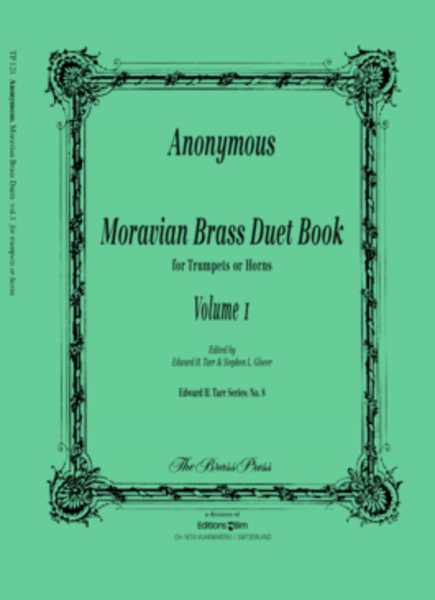Moravian Brass Duet Book Vol. 1
-
Ships in 3 to 4 weeks
Details
Description
SKU: ET.TP121
Composed by Anonymous. Arranged by Tarr / Glover. Baroque. Volume 1. Composed 18th cent. Editions BIM #TP121. Published by Editions BIM (ET.TP121).ISBN 9790207000484.
140 Duets
In reviving music written for natural trumpet, American scholars have searched far afield in European libraries. It will therefore surprise to many that an important and subslantial collection of music in Baroque style for two trumpets or which we have named The Moravian Brass Duet Book, is located in the United States of America. It might be an exageration to call this American Baroque music, but in any case it is Baroque music, played in early America. In the following paragraphs we will try to show it was used in the musical life of the German Moravian settlement in Salem (now Winston-Salem, North Carolina); the possible origin of the collection and the style of brass writing are also discussed.
It is a well-known fact that music played an extremely important part in the life of the American Moravians. This group of religious refugees had founded their first church in 1727 on the estate of their protector, Count Nicolaus Ludwig von Zinzendorf (1700-1760), and subsequently became known as Herrnhuter (after the town, Herrnhut) or as the Böhmische Brüder ot the Böhmische Brüdergemeinschaft (after their provenance). A few years later, spurred on by a desire to Christianize the heathen, some of them moved on: in 1732 to the West Indies, from 1735 to 1740 to Savannah, Georgia, in 1741 to Pennsylvania, and in 1753 to what is now North Carolina. In 1753 they took over a 100,000 acre tract of land which they named Wachovia, successively founding three settlements on it, Bethabara (1753), Bethania (1759), and Salem, which is now Winston-Salem (1766).
The Moravians brought many musical manuscripts and prints with them to the New World, including parts to symphonies of Haydn no longer to be found in Europe, and were later responsible for the first performances in America of Bach's B minor Mass and Haydn’s Creation. Moravian music-making resembled the pattern also used by the German Lutherans, a younger Protestant community. Each community had its own collegium musicum. The use of brass instruments the older tradition of tower music. They were played in church, at weddings and at the still-cintinuing justly famous Easter sunrise services. The first individual specifically identified with American Moravian music was John Böhner (1710-1785), a trumpet-playing carpenter whose playing so impressed the Georgia governor, General James Oglethorpe, that he wanted to keep him on as a trumpeter in his own employ when the Georgia colony was disbanded in 1740. (However, Böhner preferred to stay with his own people, going on to Pennsylvania and two years later to the West Indies, where he died in a colony called New Herrnut). The use of natural trumpets and horns is recorded in the Pennsylvania and Carolina settlements as well, starting in 1745.
Natural trumpetd and horns were used in Wachovia starting in 1755, and they played music of a type included in this publication as early as 1767 and 1772. The two-part from which the present publication was made could have been used then, or they could have been imported from Herrnhut in 1785. The evidence is as follow: Trumpets were brought from Pennsylvania to the Wachovia settlement and first used at morning prayer on July 22, 1755. Two more trumpets arrived from Bethlehem in November 4, 1755. Augst and Opitz rode ahead, blowing on their trumpets with the verse ‘Peace and health and every good be with you’, and the brethen of the Wachau were not slow to answer with their trumpets, and to welcome us from the peak of their new house. Like their predecessor Böhner, Augst and Opitz were not professional trumpeters, but rather a potter and a cobbler respectively. In an inventory eleven years later, the Wachovia church was recorded as owning two trumpets and two horns. (Trombones were not introduced to Bethlehem, Pennsylvania until 1754, and to Salem, Carolina until 1722.)
The duest published here, which were played by the Salem Moravians, consist of chorales, marches, minuets, and polonaises. They were probably recreational and not church music. An interesting letter from 1772 mentions the use of this kind of piece. It was written by the Aufseher Collegium to the Elders’ Conference and entered in the in the minutes of the latter on December 1, 1772. The passage in question reads:
Dear Brethren and Sisters...:
... We think it would be well abide by the [Ministers’ Conference decision] concerning playing on Sunday. In connection with the subject of Sunday we desire to say that in business nothing ought to be sold on Sunday, nor charged, neither should work be taken nor given out. Neither should the musicians play Minuets, Polonaises, Marches, or other worldly music, but rather confine themselves to Chorales...

 Share
Share